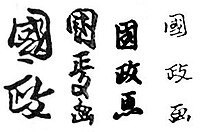Utagawa Kunimasa (歌川 国政, 1773 – December 26, 1810) was a Japanese ukiyo-e artist of the Utagawa school. He was originally from Aizu in Iwashiro Province and first worked in a dye shop after arriving in Edo (modern Tokyo). It was there that he was noticed by Utagawa Toyokuni, to whom he became apprenticed.

Kunimasa is especially known for his yakusha-e portrait prints of kabuki actors, and for his bijin-ga pictures of beautiful women. Richard Lane described his style as striving to "combine the intensity of Sharaku with the decorative pageantry of his master Toyokuni".[1] Those who make such comparison often say he failed to achieve the level of Sharaku's intensity.
-
Examples of Kunimasa's signature
-
Ichikawa Yaozo III
Notes
edit- ^ Lane, Richard (1978). Images of the Floating World. Old Saybrook, CT: Konecky & Konecky. p. 152.
References
edit- Lane, Richard. (1978). Images from the Floating World, The Japanese Print. Oxford: Oxford University Press. ISBN 9780192114471; OCLC 5246796
- Morse, Anne Nishimura (1985). "Utagawa Kunimasa". Kodansha Encyclopedia of Japan. Tokyo: Kodansha Ltd.
External links
edit- British Museum: Utagawa Kunimasa, The actor Ichikawa Ebizō in a shibaraku role, a colour woodblock print
- Art site


